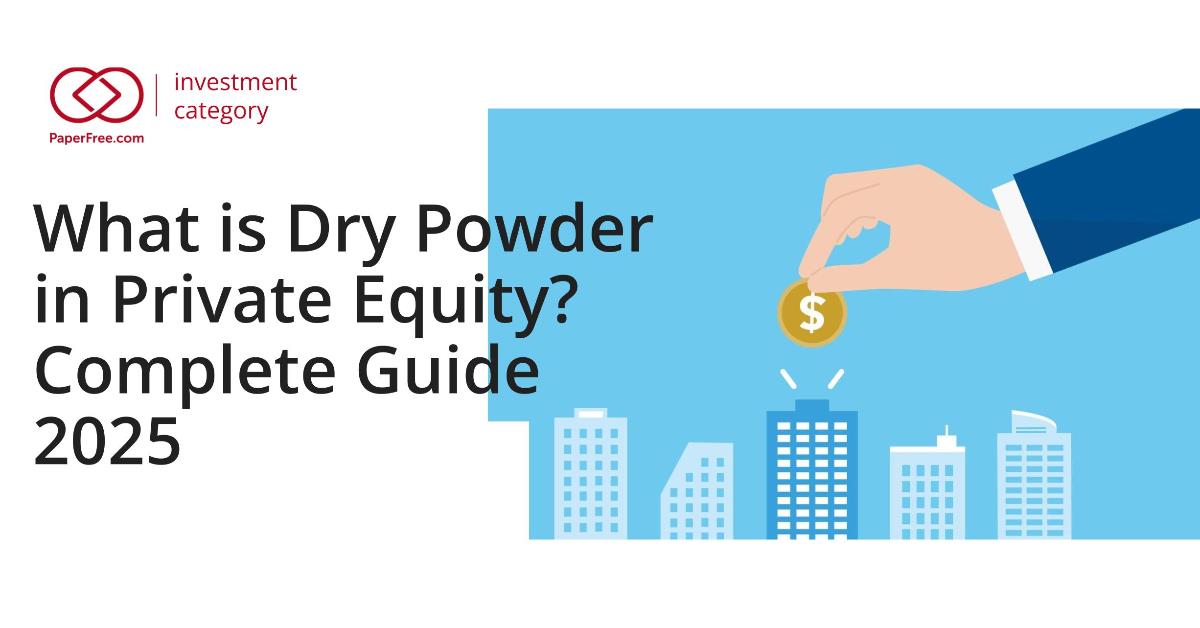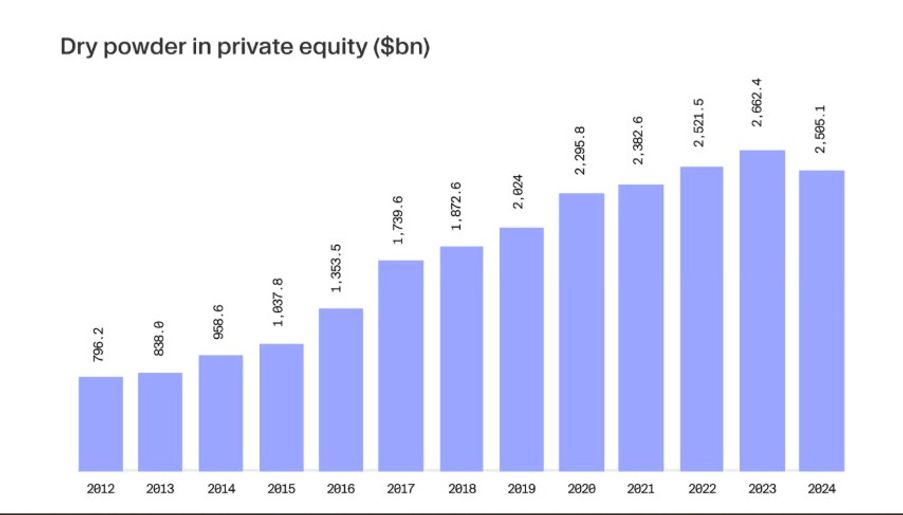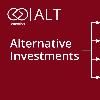What is Dry Powder in Private Equity? Complete 2025 Analysis & Market Guide
The Complete Guide to Dry Powder in 2025: Meaning, $2.5T+ Availability, Latest Deployment Trends, and Market Impactlast updated Tuesday, September 9, 2025
#what is dry powder in private equity #dry powder in private equity
| | by John Burson |

QUICK LINKS
AD
Get access to EB 5 Visa Investment Projects
Key Takeaways:
- Dry powder refers to capital reserves that private equity (PE) funds hold, ready to be deployed for investments.
- It represents committed capital from limited partners (LPs), which has been pledged but not yet invested or called by the general partner (GP).
- Dry powder serves as a strategic reserve, offering flexibility for PE firms to time investments, capitalize on market dislocations, and act quickly on opportunities.
- In 2024, global private equity dry powder reached a record high of $2.62 trillion mid-year, reflecting substantial undeployed capital within the industry.
What is Dry Powder in Private Equity?
Dry powder in private equity refers to committed but undeployed capital that private equity fund managers have readily available for immediate investment opportunities. The term "dry powder in private equity" originates from military history, where keeping gunpowder dry ensured it was ready for use when needed.
Understanding Dry Powder in Private Equity
When investors ask "what is dry powder in private equity," they’re asking about one of the most critical metrics in the alternative investment industry. Dry powder represents the financial ammunition that PE firms keep in reserve—capital that has been committed by limited partners (LPs) but not yet called for specific investments.
The dry powder meaning in private equity encompasses three key characteristics:
- Committed Capital: Money that LPs have legally pledged to provide
- Uncalled Status: Capital that hasn’t been requested by the general partner (GP)
- Ready Deployment: Funds available for immediate investment when opportunities arise
The Capital Structure Framework
To understand dry powder, it's essential to distinguish between three key concepts:
| Capital Type | Definition | Status | Example |
|---|---|---|---|
| Committed Capital | Total amount LPs pledge to fund | Contractual obligation | $100M fund commitment |
| Called Capital | Amount actually requested by GP | Deployed/Deployed | $40M called to date |
| Dry Powder | Remaining uncalled commitment | Ready for deployment | $60M available |
How Dry Powder Works in Practice
When limited partners (LPs) commit to a private equity fund, they don't transfer the entire amount upfront. Instead, they sign a legal commitment to provide capital when the general partner (GP) identifies investment opportunities. This creates a pool of readily available but undeployed capital—the dry powder.
The Capital Call Process:
- GP identifies investment opportunity
- Conducts due diligence and negotiates terms
- Issue capital call notice to LPs (typically 10-30 days advance)
- LPs transfer funds for a specific investment
- The dry powder balance reduces accordingly

How Much Dry Powder in Private Equity 2024? Record-Breaking Statistics
How Much Dry Powder in Private Equity Globally?
The answer to "how much dry powder in private equity 2024" is staggering: Global private equity dry powder reached an unprecedented $2.62 trillion at its peak in mid-2024, according to industry data. This represents the most significant accumulation of undeployed investment capital in the history of private equity.
How Much Dry Powder in Private Equity by Region (2024)
Understanding how much dry powder exists in private equity requires examining regional distribution:
Regional Distribution: How Much Dry Powder in Private Equity by Geography
| Region | Dry Powder Amount | % of Global Total | YoY Change |
|---|---|---|---|
| North America | $1.57T | 60% | -1.1% |
| Europe | $680B | 26% | +2.3% |
| Asia-Pacific | $315B | 12% | +3.8% |
| Rest of World | $55B | 2% | +1.2% |
Why So Much Dry Powder in Private Equity 2024?
The question "how much dry powder in private equity 2024" reveals unprecedented levels due to several factors:
- Vigorous Fundraising Activity: PE firms raised substantial capital in 2021-2023
- High Asset Valuations: Expensive markets made deployment challenging
- Economic Uncertainty: Interest rate changes and market volatility
- Selective Investment Approach: GPs became more cautious with deployment
Historical Context: Dry Powder in Private Equity Growth
1. Aging Capital Challenge
The value of aging dry powder (held for four years or longer) increased to 24% of the total, up from 20% in 2022. This trend creates significant pressure on fund managers to deploy capital efficiently.
2. Deployment Recovery Signals
North America’s private equity buyout market has shown signs of recovery, with available dry powder decreasing by 1.1% from December 2023 to June 2024, indicating a resurgence in investment activity.
3. Fundraising Concentration
The market is witnessing increased capital concentration, with limited partners showing a preference for larger, established managers, creating challenges for mid-market funds.
Strategic Importance of Dry Powder
1. Market Timing and Opportunistic Investing
Dry powder provides PE firms with the strategic flexibility to capitalize on market dislocations and economic downturns when asset valuations become more attractive.
Historical Deployment Patterns:
- 2008 Financial Crisis: Firms with substantial dry powder acquired distressed assets at significant discounts
- 2020 COVID-19 Pandemic: Rapid deployment in healthcare, technology, and essential services
- 2022-2023 Interest Rate Environment: Strategic take-private transactions in undervalued public companies
2. Competitive Advantage in Deal Execution
Having readily available capital allows firms to invest in promising ventures or acquisitions as soon as they emerge, without waiting for additional fundraising.
Execution Speed Benefits:
- Faster Due Diligence: No fundraising delays
- Stronger Negotiating Position: Certainty of funding
- First-Mover Advantage: Quick response to opportunities
- Reduced Execution Risk: Eliminated financing contingencies
3. Portfolio Construction and Risk Management
Strategic dry powder management enables:
- Diversification: Spread investments across sectors and geographies
- Follow-on Investments: Support portfolio companies' growth
- Add-on Acquisitions: Build platform companies through bolt-on deals
- Opportunistic Exits: Bridge financing for strategic transactions
Dry Powder Deployment Strategies
Traditional Deployment Approaches
1. Sequential Investment Strategy
- Deploy capital evenly over the investment period (typically 3-5 years)
- Reduces timing risk but may miss concentrated opportunities
- Suitable for diversified, broad-market strategies
2. Opportunistic Deployment
- Concentrate investments during market dislocations
- Higher potential returns but increased timing risk
- Requires superior market timing capabilities
3. Sector-Focused Deployment
- Target specific industries or themes
- More profound expertise and network effects
- Higher concentration risk but potential for specialized returns
Advanced Deployment Techniques
Modern Portfolio Theory Applications
| Strategy Type | Allocation % | Risk Level | Expected Return | Deployment Timeline |
|---|---|---|---|---|
| Core Holdings | 60-70% | Low-Medium | 15-20% IRR | Years 1-3 |
| Growth Opportunities | 20-25% | Medium-High | 25-35% IRR | Years 2-4 |
| Opportunistic/Distressed | 10-15% | High | 30-50% IRR | Event-driven |
Technology-Enhanced Deployment
Modern PE firms leverage:
- AI-Powered Deal Sourcing: Identify opportunities faster
- Predictive Analytics: Optimize deployment timing
- Portfolio Monitoring Systems: Track capital efficiency metrics
- Market Intelligence Platforms: Real-time industry insights
Performance Impact and Metrics
IRR Impact of Dry Powder Management
If capital remains idle for an extended period, it directly affects returns. Private equity funds typically have an investment cycle of three to five years. If a fund does not deploy its capital efficiently during this period, it leads to capital inefficiency, which reduces the IRR.
Key Performance Metrics
| Metric | Definition | Target Range | Impact on Returns |
|---|---|---|---|
| Deployment Rate | Capital invested/Total commitment | 80-95% by Year 3 | High correlation with IRR |
| Capital Efficiency | Invested capital/Called capital | >95% | Direct IRR impact |
| J-Curve Duration | Time to positive returns | 18-36 months | LP satisfaction |
| DPI (Distributions to Paid-In) | Cash returned/Capital called | 1.5x+ by maturity | Ultimate success measure |
Benchmarking Deployment Performance
Top Quartile vs. Bottom Quartile Performance (2020-2024)
| Metric | Top Quartile | Bottom Quartile | Performance Gap |
|---|---|---|---|
| Average Deployment Time | 3.2 years | 4.8 years | 1.6 years |
| Capital Efficiency | 97% | 89% | 8 percentage points |
| Net IRR | 22.3% | 11.7% | 10.6 percentage points |
| Multiple of Money | 2.4x | 1.6x | 0.8x |
Risks and Challenges of Excess Dry Powder
Market-Level Risks
1. Asset Price Inflation
With trillions of capital on the sidelines, competition to find the next unicorn is more challenging than ever, leading to:
- Valuation Multiples: Increased EV/EBITDA multiples
- Auction Processes: More competitive bidding
- Return Compression: Lower expected returns industry-wide
2. Deployment Pressure
General partners face the delicate balancing act of meeting their LPs' timing expectations while still performing ample due diligence for any investments.
Fund-Level Risks
Capital Allocation Inefficiencies
| Risk Type | Impact | Probability | Mitigation Strategy |
|---|---|---|---|
| Rushed Deployment | Lower returns | Medium | Disciplined investment committee |
| Over-Paying | Multiple compression | High | Rigorous valuation frameworks |
| Concentration Risk | Portfolio volatility | Medium | Diversification mandates |
| LP Relationship Strain | Future fundraising impact | Low | Transparent communication |
Aging Capital Consequences
- IRR Drag: Returns calculated from commitment, not deployment
- LP Dissatisfaction: Unmet deployment expectations
- Extension Risk: Need for fund life extensions
- Reputation Impact: Future fundraising challenges
Best Practices for Dry Powder Management
For General Partners
Strategic Framework
-
Investment Thesis Clarity
- Define target sectors and deal criteria upfront
- Communicate the deployment timeline to LPs
- Establish disciplined investment committee processes
-
Market Monitoring Systems
- Real-time deal flow tracking
- Competitive landscape analysis
- Economic cycle positioning
-
Capital Call Optimization
- Just-in-time capital calling
- Minimize cash drag
- Coordinate with deal closing timelines
Operational Excellence
| Best Practice | Implementation | Expected Benefit |
|---|---|---|
| Pipeline Management | CRM systems, deal scoring | 20-30% faster deployment |
| Due Diligence Standardization | Checklist automation | 15-25% time reduction |
| Market Intelligence | Industry databases, expert networks | Better timing decisions |
| LP Communication | Quarterly updates, deployment dashboards | Enhanced relationships |
For Limited Partners
Due Diligence Focus Areas
-
Manager Selection Criteria
- Historical deployment patterns
- Market cycle performance
- Investment discipline track record
-
Portfolio Construction
- Vintage year diversification
- Manager style allocation
- Capital commitment pacing
Monitoring and Oversight
| LP Monitoring Tool | Purpose | Frequency |
|---|---|---|
| Capital Call Analysis | Deployment pace tracking | Monthly |
| Benchmark Comparison | Relative performance assessment | Quarterly |
| Market Environment Review | Context for deployment decisions | Quarterly |
| Manager Assessment | Ongoing capability evaluation | Annual |
Technology and Innovation in Dry Powder Management
AI and Machine Learning Applications
Deal Sourcing Enhancement
- Pattern Recognition: Identify successful deal characteristics
- Market Scanning: Automated opportunity identification
- Predictive Modeling: Forecast deployment opportunities
Portfolio Optimization
- Risk Assessment: Dynamic risk modeling
- Capital Allocation: Optimal deployment strategies
- Performance Prediction: Expected return modeling
Digital Infrastructure
| Technology Solution | Use Case | Efficiency Gain |
|---|---|---|
| Cloud-Based CRM | Deal pipeline management | 25-40% |
| Data Analytics Platforms | Market intelligence | 30-50% |
| Automated Reporting | LP communications | 60-80% |
| Digital Due Diligence | Investment evaluation | 20-35% |
Regulatory and Compliance Considerations
Regulatory Framework Impact
SEC Regulations (US)
- Form ADV reporting requirements
- LP capital call disclosures
- Investment timing documentation
AIFMD (Europe)
- Dry powder reporting obligations
- Risk management requirements
- Investor protection measures
Compliance Best Practices
-
Documentation Standards
- Capital call justification
- Investment committee minutes
- LP communication records
-
Risk Management
- Deployment pace monitoring
- Concentration limits
- Liquidity stress testing
Future Outlook: Dry Powder Trends Through 2025-2027
Market Predictions
Short-Term Outlook (2025)
- Gradual Deployment Recovery: The long-term outlook for private equity remains robust, driven by continued attractive opportunities
- Interest Rate Normalization: Lower rates should improve deployment conditions
- Market Cycle Positioning: Opportunities from economic transitions
Medium-Term Trends (2026-2027)
- Technology Integration: AI-enhanced deployment strategies
- ESG Focus: Sustainability-driven investment themes
- Emerging Markets: Geographic diversification of deployment
Strategic Implications
For Fund Managers
- Competitive Differentiation: Superior deployment capabilities as a key differentiator
- Technology Investment: Digital transformation for operational advantage
- Specialized Strategies: Niche expertise to justify premium valuations
for Institutional Investors
- Manager Selection: Enhanced focus on deployment track record
- Portfolio Construction: Strategic vintage year and style diversification
- Alternative Structures: Consideration of evergreen and hybrid funds
Frequently Asked Questions (FAQ)
Q: What is dry powder in private equity in simple terms?
A: Dry powder in private equity is money that investors have promised to give to private equity funds, but the fund managers haven't used it yet for investments. Think of it as cash sitting in reserve, ready to be deployed when good investment opportunities arise.
Q: What does the meaning of dry powder in private equity tell us about the market?
A: The dry powder meaning in private equity serves as a market indicator. High levels suggest either strong investor confidence (lots of money raised) or challenging market conditions (difficulty finding good investments). The current $2.62 trillion represents both strong fundraising success and deployment challenges.
Q: How much dry powder in private equity is considered normal?
A: There's no "normal" amount, but the current $2.62 trillion in 2024 is historically unprecedented. Typically, dry powder levels fluctuate between $1-2 trillion globally, making current levels exceptionally high and creating significant deployment pressure on fund managers.
Q: What is dry powder in private equity used for?
A: Dry powder in private equity is used for new company acquisitions, follow-on investments in existing portfolio companies, add-on acquisitions to build larger platforms, growth capital for expansion, and opportunistic investments during market downturns.
Q: How much dry powder is in private equity 2024 compared to previous years?
A: The $2.62 trillion in dry powder for 2024 represents a significant increase from historical averages. This level is approximately 30-40% higher than typical years, creating unprecedented competition for quality investment opportunities and putting pressure on asset valuations.
Dry Powder in Private Equity’s Future Impact
Understanding "what is dry powder in private equity" is crucial for anyone involved in alternative investments. With $2.62 trillion in dry powder in private equity as of 2024, the industry faces both unprecedented opportunities and significant challenges.
The massive amount of dry powder in private equity 2024 will shape investment strategies, market valuations, and competitive dynamics for years to come. The concept of dry powder in private equity extends beyond simple capital availability—it represents the industry's collective capacity to capitalize on opportunities, support economic growth, and generate returns for institutional investors.
Key Success Factors:
- Disciplined Investment Approach
Maintaining investment standards despite deployment pressure - Technology Integration
Leveraging AI and analytics for enhanced decision-making - Market Timing Capabilities
Understanding cycle dynamics and positioning accordingly - Operational Excellence
Streamlined processes for rapid deployment when opportunities arise - Stakeholder Communication
Transparent reporting and expectation management with LPs
The private equity industry’s ability to effectively deploy this historic level of dry powder will significantly influence market dynamics, investment returns, and capital formation patterns for years to come.
Disclaimer: This analysis is based on industry data through August 2025 and includes insights from leading market research firms, private equity organizations, and regulatory sources. Investment decisions should always be made with the guidance of appropriate professional advice and thorough due diligence.
Free Consultation
Similar Pages
- Paperfree US | investment opportunities: real estate, private equity, private credit & more

- 4 Ways to Better Organize Inventory Management

- Marketing Strategies for Optimum B2B Lead Generation

- How to Spot and Avoid Hard Money Scams

- 6 Reasons Why Jumbo Mortgage Refinance is a Good Option

- The Lender Checklist: Finding a Solid Real Estate Investment

- Non institutional lenders are taking the center stage

- [closed] CMF. Cedar Multifamily Fund
![[closed] CMF. Cedar Multifamily Fund](https://d2sv4n3pfes7l9.cloudfront.net/file_paperfree_144_2020-8-21-19-57-p_pf-avatar.jpg)
Popular
Benefits of the EB-5 Visa Program | Guide
Search within Paperfree.com
